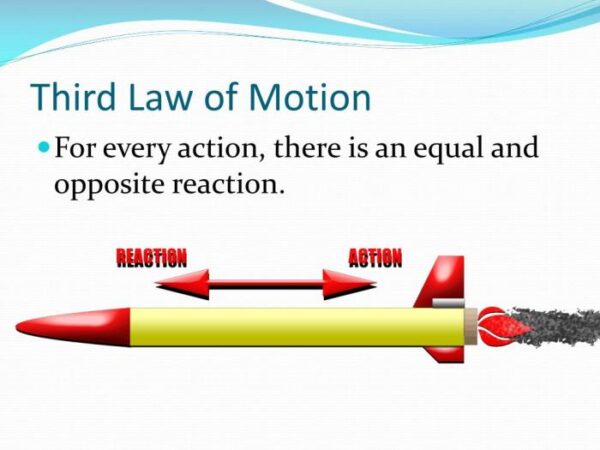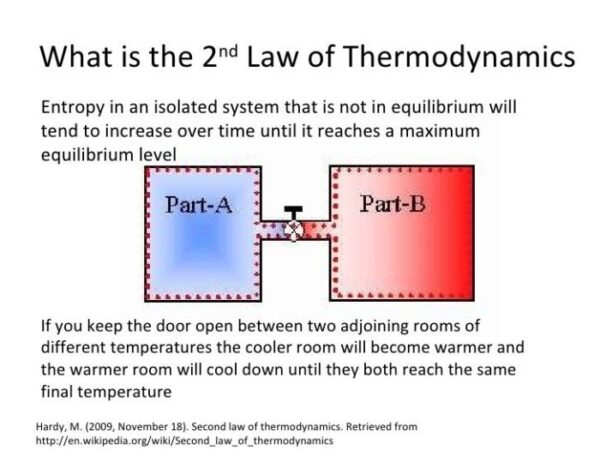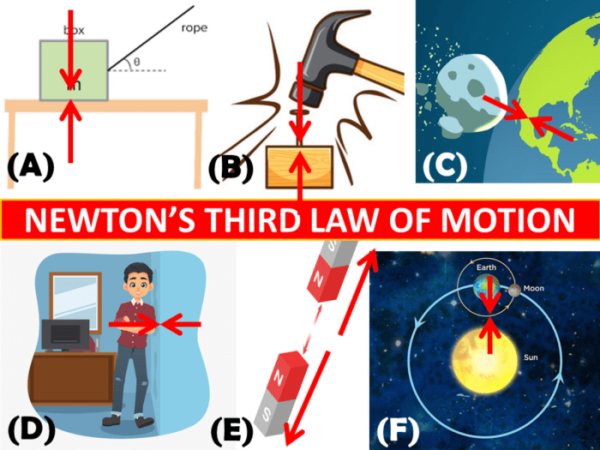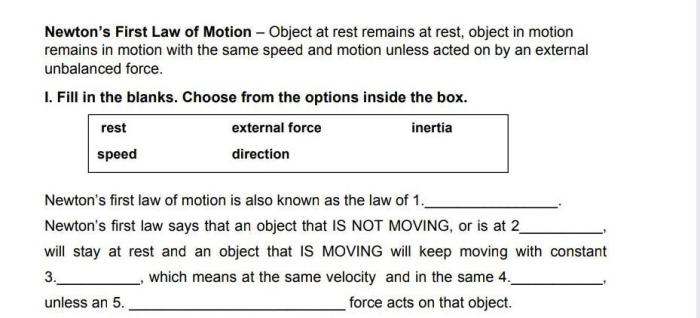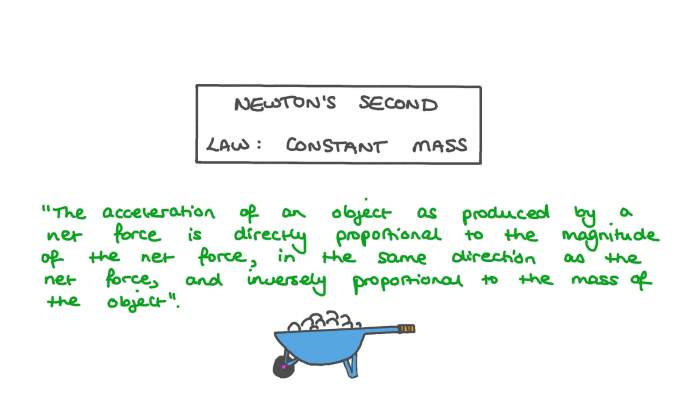
What law is known for the law of action? It’s none other than Newton’s Third Law of Motion, a fundamental principle that governs the interactions between objects in our universe. This law states that for every action, there is an equal and opposite reaction. This simple yet profound concept has far-reaching implications, impacting everything from the movement of planets to the design of rockets and even the way we walk.
Newton’s Third Law is a cornerstone of classical mechanics, offering a framework for understanding the forces that shape our world. It provides a clear explanation for how objects interact and influence each other’s motion. This law isn’t just a theoretical concept; it’s a demonstrable reality that we encounter in our everyday lives.
Newton’s Third Law of Motion
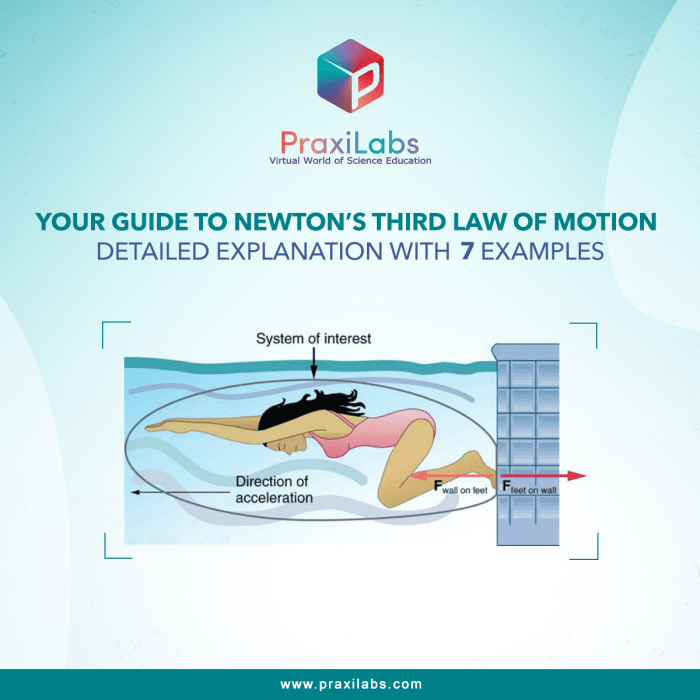
Newton’s Third Law of Motion, often referred to as the law of action and reaction, is a fundamental principle in physics that governs the interactions between objects. It describes the relationship between forces exerted by objects upon each other.
Action and Reaction Forces
Newton’s Third Law states that for every action, there is an equal and opposite reaction. This means that when one object exerts a force on another object (the action force), the second object simultaneously exerts an equal and opposite force back on the first object (the reaction force). These forces always occur in pairs, and they act on different objects.
Real-World Examples
Rocket Launch
During a rocket launch, the rocket engines expel hot gases downward, creating a downward action force. In response, the gases exert an equal and opposite upward reaction force on the rocket, propelling it upwards.
Person Walking
When a person walks, they push their foot backward against the ground (action force). The ground, in turn, pushes forward on the person’s foot with an equal and opposite reaction force. This reaction force is what propels the person forward.
Forces in a Simple Interaction
Consider a ball hitting a wall. When the ball strikes the wall, it exerts a force on the wall (action force). Simultaneously, the wall exerts an equal and opposite force on the ball (reaction force). The action force causes the ball to deform and change direction, while the reaction force causes the wall to experience a slight vibration or deformation.
Direction and Magnitude of Forces
The action and reaction forces always act in opposite directions. The magnitude of the action force is always equal to the magnitude of the reaction force. For example, if a ball exerts a force of 10 Newtons on a wall, the wall will exert a force of 10 Newtons back on the ball.
Applications of Newton’s Third Law
Newton’s Third Law of Motion, stating that for every action, there is an equal and opposite reaction, is a fundamental principle in physics that governs the interactions between objects. This law has profound implications for understanding how objects move and how forces act upon them, and its applications extend far beyond the realm of theoretical physics.
Everyday Applications
Newton’s Third Law is at play in numerous everyday scenarios, often unnoticed but always present. Walking, for instance, involves pushing against the ground (action) and the ground pushing back with an equal and opposite force (reaction), propelling us forward. Similarly, when swimming, we push water backward (action) and the water pushes us forward (reaction).
- Pushing a wall: When you push against a wall, the wall exerts an equal and opposite force back on you, preventing you from moving through it.
- Jumping: When you jump, you push down on the ground (action), and the ground pushes back up on you (reaction), launching you into the air.
- Rockets: Rockets work by expelling hot gases downward (action), which in turn propels the rocket upward (reaction).
Applications in Vehicles and Machines
Newton’s Third Law plays a crucial role in the operation of vehicles and various machines.
- Cars: The engine of a car burns fuel, creating an explosion that pushes the piston downward (action). This force is transmitted to the wheels, which push against the ground (action), causing the car to move forward (reaction).
- Aircraft: Airplane engines generate thrust by expelling hot air backward (action), propelling the plane forward (reaction). The wings of the aircraft also create lift by pushing air downward (action), resulting in an upward force (reaction).
- Bicycles: When you pedal a bicycle, you apply force to the pedals (action), which turns the wheels. The wheels push against the ground (action), causing the bicycle to move forward (reaction).
Applications in Various Fields
| Field | Application | Explanation |
|---|---|---|
| Physics | Conservation of momentum | The total momentum of a system remains constant in the absence of external forces. This principle directly stems from Newton’s Third Law. |
| Engineering | Design of rockets and spacecraft | Engineers use Newton’s Third Law to calculate the thrust required for launching rockets and spacecraft into space. |
| Biology | Animal locomotion | Animals use Newton’s Third Law to move. For example, birds flap their wings to push air downward (action), propelling themselves upward (reaction). |
Examples in Daily Life
- Hammering a nail: When you strike a nail with a hammer, the hammer exerts a force on the nail (action), and the nail exerts an equal and opposite force back on the hammer (reaction).
- Kicking a ball: When you kick a ball, your foot exerts a force on the ball (action), and the ball exerts an equal and opposite force back on your foot (reaction).
- Opening a door: When you push a door open, you exert a force on the door (action), and the door exerts an equal and opposite force back on you (reaction).
Thought Experiment
Imagine you are standing on a skateboard and throw a heavy ball forward. According to Newton’s Third Law, the ball will exert an equal and opposite force on you. This will cause you to roll backward on the skateboard. The heavier the ball, the greater the force it exerts on you, and the faster you will roll backward. This experiment highlights the importance of understanding the action-reaction principle, as it demonstrates how forces can affect the motion of objects even when they are not in direct contact.
Historical Context and Development: What Law Is Known For The Law Of Action
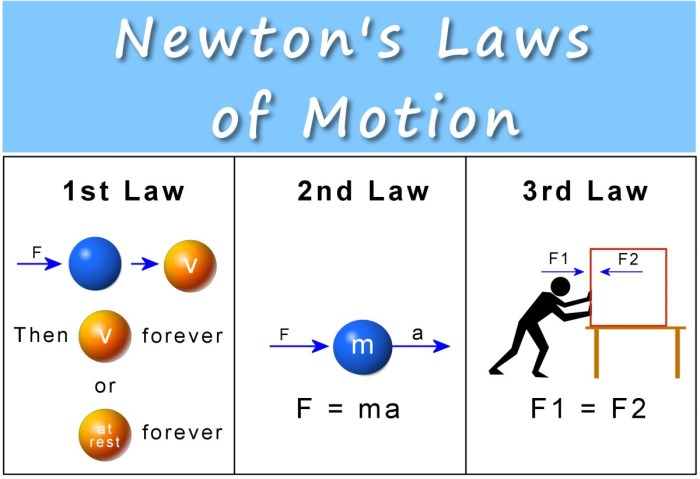
Newton’s Third Law of Motion, a fundamental principle in physics, did not emerge in a vacuum. It was the culmination of centuries of scientific inquiry and the contributions of numerous brilliant minds. Understanding its historical context reveals the intricate tapestry of ideas and observations that led to its formulation.
Influential Scientists and Their Contributions
The development of Newton’s Third Law was influenced by the work of several notable scientists who came before him.
- Aristotle (384-322 BC): Aristotle, a Greek philosopher, was one of the first to propose ideas about motion. He believed that objects moved because of an inherent tendency to reach their natural place. For example, he thought that rocks fall to the ground because their natural place is the center of the universe. While Aristotle’s ideas were influential for centuries, they were ultimately proven incorrect by later scientists.
- Johannes Kepler (1571-1630): Kepler, a German astronomer, made significant contributions to our understanding of planetary motion. His laws of planetary motion described how planets orbit the sun, paving the way for Newton’s later work on gravity.
- Galileo Galilei (1564-1642): Galileo, an Italian astronomer and physicist, made groundbreaking observations and experiments that challenged Aristotle’s ideas about motion. He demonstrated that objects fall at the same rate regardless of their mass and that motion is relative. His work on inertia was a crucial precursor to Newton’s First Law of Motion.
- René Descartes (1596-1650): Descartes, a French philosopher and mathematician, developed the concept of momentum, which played a key role in Newton’s formulation of the Third Law. He proposed that momentum, a measure of an object’s mass and velocity, is conserved in collisions.
Key Experiments and Observations
Newton’s Third Law was not simply a theoretical construct; it was grounded in observations and experiments.
- Observation of Collisions: Newton observed that when two objects collide, they exert equal and opposite forces on each other. For example, when a billiard ball strikes another, both balls experience a force, and the direction of these forces is opposite.
- Experiments with Magnets: Newton conducted experiments with magnets, observing that when two magnets attract or repel each other, they exert equal and opposite forces.
- Observations of Rockets: Newton observed that rockets propel themselves forward by expelling gas backward. This observation demonstrated the principle of action and reaction, where the force of the gas pushing backward is equal and opposite to the force that propels the rocket forward.
Scientific Advancements Following Newton’s Third Law
The discovery of Newton’s Third Law had profound implications for scientific understanding and led to numerous advancements.
- Understanding of Momentum Conservation: Newton’s Third Law provided a deeper understanding of the principle of momentum conservation. Momentum is a measure of an object’s mass and velocity, and in a closed system, the total momentum remains constant, even though individual objects may exchange momentum through collisions or interactions.
- Development of Rocket Propulsion: Newton’s Third Law became the foundation for the development of rocket propulsion. The principle of action and reaction is central to how rockets work, with the expulsion of hot gas providing the force to propel the rocket forward.
- Advancements in Engineering: Newton’s Third Law has played a crucial role in various engineering applications, from the design of bridges and buildings to the development of vehicles and aircraft. Understanding the forces involved in interactions is essential for ensuring structural stability and efficient operation.
Timeline of Development
| Date | Event |
|---|---|
| 384-322 BC | Aristotle proposes ideas about motion, including the concept of natural place. |
| 1571-1630 | Johannes Kepler formulates his laws of planetary motion, describing how planets orbit the sun. |
| 1564-1642 | Galileo Galilei conducts experiments and observations that challenge Aristotle’s ideas about motion, demonstrating the concept of inertia. |
| 1596-1650 | René Descartes develops the concept of momentum, which is crucial to Newton’s Third Law. |
| 1687 | Isaac Newton publishes *Philosophiæ Naturalis Principia Mathematica*, which includes his three laws of motion, including the Third Law. |
Misconceptions and Common Errors
Newton’s Third Law, while simple in its statement, often leads to misunderstandings and misapplications. This is because the law’s core principle, “for every action, there is an equal and opposite reaction,” can be interpreted out of context. Understanding the limitations and nuances of the law is crucial for applying it correctly.
Misconceptions about Newton’s Third Law
The following points highlight common misconceptions surrounding Newton’s Third Law:
- Action and Reaction Forces Act on the Same Object: A common misconception is that the action and reaction forces act on the same object. However, Newton’s Third Law states that the forces act on *different* objects. For instance, when you push against a wall, the wall pushes back on you with an equal and opposite force. The force you exert is the action, and the force the wall exerts on you is the reaction. These forces act on different objects: you and the wall.
- Forces Always Cancel Out: Another misconception is that the action and reaction forces always cancel out, resulting in no net force. While it’s true that the forces are equal and opposite, they act on *different* objects, so they don’t cancel each other out. The net force on each object depends on the other forces acting on it.
- Action and Reaction Forces Occur Simultaneously: The misconception arises that the action and reaction forces occur simultaneously. However, the forces are simultaneous only in a theoretical ideal scenario. In reality, there is a slight delay between the action and reaction due to the finite speed of light and the time it takes for information to travel between objects.
Limitations of Newton’s Third Law
Newton’s Third Law has limitations and is not applicable in all scenarios. The following points explain the law’s limitations:
- Non-Inertial Frames of Reference: Newton’s Third Law holds true only in inertial frames of reference, where objects at rest remain at rest and objects in motion continue moving at a constant velocity unless acted upon by a net force. In non-inertial frames, such as a rotating frame, the law might not hold true.
- Non-Contact Forces: Newton’s Third Law primarily applies to contact forces, where objects directly interact with each other. It may not directly apply to non-contact forces, such as gravitational forces, where the forces act at a distance.
- Relativistic Effects: At very high speeds, close to the speed of light, relativistic effects become significant. Newton’s Third Law breaks down in these scenarios, and the laws of special relativity are required to describe the interaction between objects.
Understanding the Context
Understanding the context in which Newton’s Third Law applies is crucial for avoiding errors.
- Identifying the Action and Reaction Forces: Carefully identify the action and reaction forces involved in a situation. Ensure that the forces act on *different* objects.
- Considering Other Forces: Remember that the action and reaction forces are only *one* pair of forces acting on the objects involved. Consider all other forces acting on the objects, such as friction, gravity, and normal forces, to determine the net force and resulting motion.
- Considering the Frame of Reference: Newton’s Third Law holds true only in inertial frames of reference. Ensure that the frame of reference you are considering is inertial.
Examples of Misinterpretations
The following examples illustrate common misinterpretations of Newton’s Third Law:
- The Case of a Book on a Table: Consider a book resting on a table. The book exerts a downward force on the table due to gravity, and the table exerts an upward force on the book, preventing it from falling. This is a classic example of Newton’s Third Law. However, some might mistakenly think that the forces cancel out, leading to no net force on the book. However, the forces don’t cancel out because they act on different objects. The net force on the book is zero, but this is due to the balance of the gravitational force and the normal force exerted by the table.
- The Case of a Rocket: A rocket propels itself forward by expelling hot gases backward. The rocket exerts a force on the gases, and the gases exert an equal and opposite force on the rocket, propelling it forward. Some might incorrectly think that the rocket’s forward motion is due to the rocket pushing against the air. However, the rocket can accelerate even in a vacuum, where there is no air to push against. The force that propels the rocket forward is the reaction force exerted by the expelled gases.
Guide to Avoid Common Errors, What law is known for the law of action
Here’s a guide to help you avoid common errors when applying Newton’s Third Law:
- Identify the Objects: Clearly identify the two objects involved in the interaction.
- Identify the Action and Reaction Forces: Identify the force exerted by one object on the other (action) and the force exerted by the second object on the first (reaction).
- Verify the Forces Act on Different Objects: Ensure that the action and reaction forces act on *different* objects.
- Consider Other Forces: Take into account all other forces acting on the objects involved in the interaction.
- Ensure Inertial Frame of Reference: Make sure the frame of reference you are considering is inertial.
Impact on Modern Science and Technology

Newton’s Third Law has profoundly shaped our understanding of the physical world, influencing not only fundamental scientific principles but also the development of groundbreaking technologies. This law, stating that for every action, there is an equal and opposite reaction, provides a framework for comprehending the interaction of forces in various systems, from the intricate workings of a rocket engine to the delicate balance of a suspension bridge.
Influence on Scientific Understanding
Newton’s Third Law has been instrumental in advancing our understanding of fundamental scientific concepts. Its principle of action-reaction helps explain the motion of objects in various scenarios, including collisions, explosions, and the movement of celestial bodies. This law is essential for understanding the conservation of momentum, a key principle in physics that states that the total momentum of a closed system remains constant.
Role in Space Exploration and Robotics
The principles of Newton’s Third Law are central to space exploration. Rocket propulsion relies on the law of action-reaction, where the expulsion of hot gases from the rocket engine generates an equal and opposite force that propels the rocket forward. This principle is also essential for understanding the motion of spacecraft in orbit and the maneuvers used to navigate through space.
Robotics, a field deeply intertwined with the principles of physics, leverages Newton’s Third Law in various ways. For instance, the design of robotic arms and manipulators relies on the understanding of forces and their interactions. Robots equipped with grippers or actuators utilize the law of action-reaction to manipulate objects, ensuring a controlled and precise movement.
Applications in Technological Advancements
Newton’s Third Law finds numerous applications in the design and development of new technologies.
Examples of Applications
- Automotive Industry: The design of vehicle suspension systems, shock absorbers, and airbags incorporates the principles of Newton’s Third Law to absorb and dissipate forces during collisions, protecting passengers. The braking system of a car, relying on friction between brake pads and rotors, also exemplifies the action-reaction principle, where the force applied to the brakes results in a deceleration of the vehicle.
- Aeronautical Engineering: Aircraft design leverages the law of action-reaction in numerous ways. The generation of lift by an airplane wing is based on the principle that the downward force exerted on the air by the wing generates an equal and opposite upward force on the aircraft. Similarly, the control surfaces, such as ailerons and rudders, rely on the action-reaction principle to maneuver the aircraft.
- Construction and Civil Engineering: The construction of bridges and buildings relies on the principles of Newton’s Third Law to ensure structural stability. The design of foundations, beams, and columns incorporates the understanding of forces and their distribution, ensuring that the structure can withstand the forces exerted upon it.
Influence on Everyday Objects
The principle of action-reaction influences the design of everyday objects. For instance, the simple act of walking relies on the law of action-reaction. When we push our foot against the ground, the ground exerts an equal and opposite force back on us, propelling us forward.
Examples of Everyday Applications
- Walking: The force we exert on the ground when taking a step creates an equal and opposite force that propels us forward.
- Swimming: The act of swimming involves pushing water backward, generating an equal and opposite force that propels us forward.
- Rowing: The force exerted on the oars by the rower creates an equal and opposite force that propels the boat forward.
- Jumping: When we jump, we push down on the ground, and the ground pushes back up on us, launching us into the air.
Applications in Various Industries
| Industry | Application of Newton’s Third Law |
|---|---|
| Aerospace | Rocket propulsion, spacecraft maneuvering, satellite stabilization |
| Automotive | Vehicle suspension systems, braking systems, airbags |
| Robotics | Robotic arms, grippers, actuators |
| Construction | Bridge design, building foundations, structural stability |
| Sports | Running, jumping, swimming, rowing |
| Manufacturing | Machine design, material handling, automated systems |
Closing Summary
Newton’s Third Law of Motion is a powerful tool for understanding the mechanics of our universe. It’s a testament to the interconnectedness of all things, reminding us that every action, no matter how small, has a corresponding reaction. From the simplest interactions to the grandest cosmic events, this law governs the dance of forces, shaping the world we see and experience. By grasping the principles of action and reaction, we gain a deeper understanding of the intricate workings of the universe and the forces that govern our world.
Expert Answers
What are some real-world examples of Newton’s Third Law?
Examples include a swimmer pushing off the wall of a pool, a rocket launching into space, a person walking, and a car accelerating on a road.
How does Newton’s Third Law relate to the concept of momentum?
Newton’s Third Law is closely related to the conservation of momentum. In a closed system, the total momentum remains constant, even though individual objects may experience changes in momentum due to interactions.
Does Newton’s Third Law apply to all forces?
While Newton’s Third Law applies to most forces, there are some exceptions, such as magnetic forces. However, it’s a fundamental principle that governs a wide range of physical interactions.
